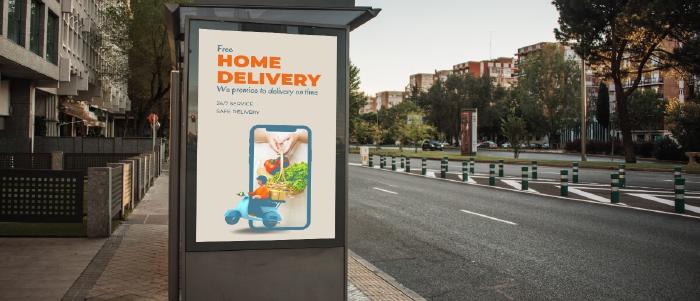
Mar 10 2025
8 min read

Before delving into the suitability of consumer-grade TVs for digital signage, consider this: if a regular TV could fulfill all the requirements, would commercial digital signage even exist?
Would there be so much discussion about the ROIs of digital signage? Apparently, the answer looks like a no. Let me tell you; there exists a slight fallacy here and there.
Television screens are not designed to be used 24 hours a day, and if done for prolonged periods, they can be affected by image retention issues and color fade (those rainbow panels on the top left of your display).
Unlike household TVs that rely on built-in media players, commercial setups often use specialized digital signage players. These digital signage players are purpose-built to handle continuous, high-performance content playback, offering robust connectivity options and content management features that standard television boxes simply cannot match.
Besides the installation cost, which is much less than commercial electronic signage hardware, does it make sense to use consumer-grade TVs as digital signage? Let’s find out!

Ticks and misses!
The answer is both a yes and a no! In millennial terms - it depends! Well, here, it indeed does!
If you are a small business such as a local eatery, bookstore, cafe, or library, using household TV as a signage screen might be the right idea to cut back on costs yet, keep your promo on point!
However, in such cases, you should ensure that your TV:
is placed indoors
gets at least 30 minutes of cooling time after every 9-10 hours (so you need to switch it off at roughly 10 hours interval)
uses licensed content management software instead of USB sticks
Also read: Why should you avoid using USB sticks for signage screens?
Nowadays, many domestic smart TVs from Samsung, LG, and TCL have more robust, higher resolutions & brightness, allowing them to be used as digital signage. So, if your business doesn’t require your digital signage to be always ON or placed outdoors, go ahead and use your home television instead of a commercial display.
| Feature | Commercial Displays | TV Displays |
|---|---|---|
| Brightness | 3,500+ nits | 300–1,000 nits |
| Lifespan | 12+ years | 5–7 years |
| Cost | $1,000–5,000+ | $200–2,000 |
| Warranty | 3–5 years (commercial use) | 1–2 years (voided commercially) |
| Content Management | Advanced software integrations | Basic streaming apps |
Now that we know both regular TVs and commercial screens can be used as digital signage depending on the operating hours and screen placement, let’s find out the pros & cons of each of these categories.
Commercial-grade digital screens can be anything, from a large-format digital billboard to an interactive kiosk.
Durability: Commercial displays are designed to operate 24/7 and are built with protective sheaths that guard the screen against environmental impacts, such as harsh weather conditions, dust, and other external damage-inducing factors.
Connectivity: Commercial digital signage screens offer a wide range of inputs, such as multiple HDMI & USB ports, VGA (Video Graphics Arrays), DVI (digital visual interface), and RS-232 inputs. Such a wide variety of input systems allow greater flexibility in running the content.
For example, multiple commercial screens can be connected via these ports to show content in a large format or a Custom Integrated Audio/Video (A/V) system.
Brightness: Since commercial signage screens, such as digital billboards, footpath digital posters, or car-top mobile digital boards, are for outdoor usage, viewership from a distance is an indispensable factor. And this is why a commercial display is likely to be 10x brighter than an ordinary television screen.
According to LG, Further, the display technology also affects the picture clarity or the resolution of a screen.Take a look at this example:

No screen burn: Screen burn is what (in layman’s terms) call a display’s “primal fear.” Playing the same content on an LCD display (which is often the display technology used in TVs) can lead to screen-burns.
A screen burn is a permanent discoloration of the screen that makes the media playing appear blurred (called Ghost images), giving you the near identical experience of watching a 3D movie without the 3D glasses.

A commercial display has advanced anti-burn enablers to avoid this problem, making them more sustainable.
Many modern smart TVs have free apps to stream live or OTT content and play games. But if you need to show business content like brand advertisements, product promotions, welcome messages, or bulletin boards, you will need to download digital signage software on your TV.
HD resolutions are available: Most modern HD smart TVs offer a minimum of 1080p screen resolution, while 4K Ultra HD televisions are also plenty in the market. The picture quality of the content shown will be clearer, meaning you can view it better from a distance.
Pixel density is decent enough for commercial use: This is the winning bet for 4K TVs! The size and resolution of a screen determine its pixel density. A 32-inch display with 1080p resolution will have a much lower pixel density than a 55-inch display with a 4K resolution― making it the most in-demand TV screen category for digital signage.
Highly economical: Consumer TV displays cost much lower than commercial digital signage models. A regular home TV can cost as low as $100, whereas industrial-grade screens may cost as high as $1299.
Less hassle on set up: People testing the ROIs of digital sign software or digital signage in general for their businesses often go for the TV options. It is not only because of the low costs involved but also because of the easy setup process. Since commercial screens do not have a TV’s ‘sit-on-the-desk’ form factor, it requires the help of professional technicians for installation. With TV screens, you can do the installation yourself.
Now that we’ve understood about the advantages of using digital signage displays for commercial use, here are real-world case studies featuring digital signage display uses.
While there are hundreds of efficient commercial screens available on the market, here are some of my favorites.

Well, not many of us can imagine the word “digital” without Samsung’s name popping up somewhere in our minds!?
And the latest Samsung OH65A-S is just what you need for all your digital signage display needs. HWile there are no restraints in using this model for indoor needs, this model is engineered exclusively for outdoor use.
With robust hardware, optimized protection features, and an advanced internal cooling system, it is UL-verified for outdoor visibility with brightness levels exceeding 3,500 nits—ensuring clear visibility over long distances.
Check out: Pickcel's designated digital signage player for samsung tv
2. Mimo Myst Link (2025 Edition)

Mimo Monitors launched Mimo Myst Link, a first-of-a-kind small format touch displays designed for optimum outdoor performance. These are available with or without an Android player and work at an extended temperature range, from -28.8 to 60 degrees Celsius, making it ideal year-round, irrespective of the climatic conditions.
Additional features include 1500 nits and light sensors that adjust the display’s brightness during cloudy days and at night.
3.Raspberry Pi 7" multi-touch display

The trending name in the world of commercial displays, Raspberry Pi is here with a unique and cutesy solution to indoor digital signage screens - the 7-inch multitouch display! The display uses capacitive touch sensors and can detect upto 10 fingers at a time. The display resolution is 800 x 480 pixels and it comes with a virtual keyboard. Ideal for your office’s visitor management system or retail Point-of-Sale advertising.
Also read: A comprehensive guide to setting up raspberry pi signage
Now, if you are planning to install a TV screen in your store to simply show a sports broadcast or play your product features when a customer is curious? Gotta check these three high-end, mid-budget, and low-cost screens with excellent reflection handling and good brightness levels that are sure to grab a few eyeballs!
1.Samsung QN95C QLED TV (2025 Edition)

The high-end Samsung QN95C Offers a signature 4K experience with Mini-LED backlight technology for excellent brightness and reflection handling. Its wide viewing angle makes it suitable for businesses such as sports arenas and stadiums, restaurants, malls or digital classrooms.
2. HISENSE U9H

The new Hisense U9H model falls moderately under budget. The model uses advanced mini-LED technology to deliver impressive anti-glare performance and optimal brightness adjustments. Hisense U9H runs the Google TV smart interface, allowing for a super-easy selection of streaming platforms and voice assistant integration.
3.TCL 5 Series S556 (2025 Edition)

There is no one-size-fits-all answer when comparing commercial digital signage displays and consumer TV displays.
It all depends on what your digital signage game plan is and how much you are willing to invest. As long as you are cognizant of the risks & benefits of each, you can take a calculated decision. The more important thing is to choose the right digital signage software because that is ultimately the tool that drives your content on screen.
Ready to upgrade?
Explore our range of SMART SCREENS & DIGITAL SIGNAGE SOLUTIONS to find the perfect match for your business needs. You can also avail a free demo & consultation or start a free 14-day trial to test our software platform on two displays (no credit card required for registration).

Digital signage displays are designed for 24/7 commercial use, while TVs are for home entertainment.
Generally, consumer TVs are not designed for nonstop operation. Extended use may lead to issues like screen burn, color fading, and warranty limitations.
Yes. Platforms like Pickcel offer remote management, scheduling, and analytics.
Commercial screens cost more upfront but last longer (12+ years). TVs are cheaper but require frequent replacements.

Mar 10 2025
8 min read

Oct 18 2022
13 min read
![What are 3D digital billboards for advertising? [5 Examples]](/blog/images/3d-advertising-billboard/banner_hu3a52995533a2f5f6af3321531a883f0d_86539_700x0_resize_q75_box.jpg)
Sep 8 2022
6 min read

Jul 15 2022
11 min read
Take complete control of what you show on your digital signage & how you show it.
Start Free Trial Schedule My DemoManaging 100s of Screens Outside Glitch-Free — Discover How Ideawale Executed Countrywide Ads and Saw 210% Increase in Sales
Unlock Exclusive Insights